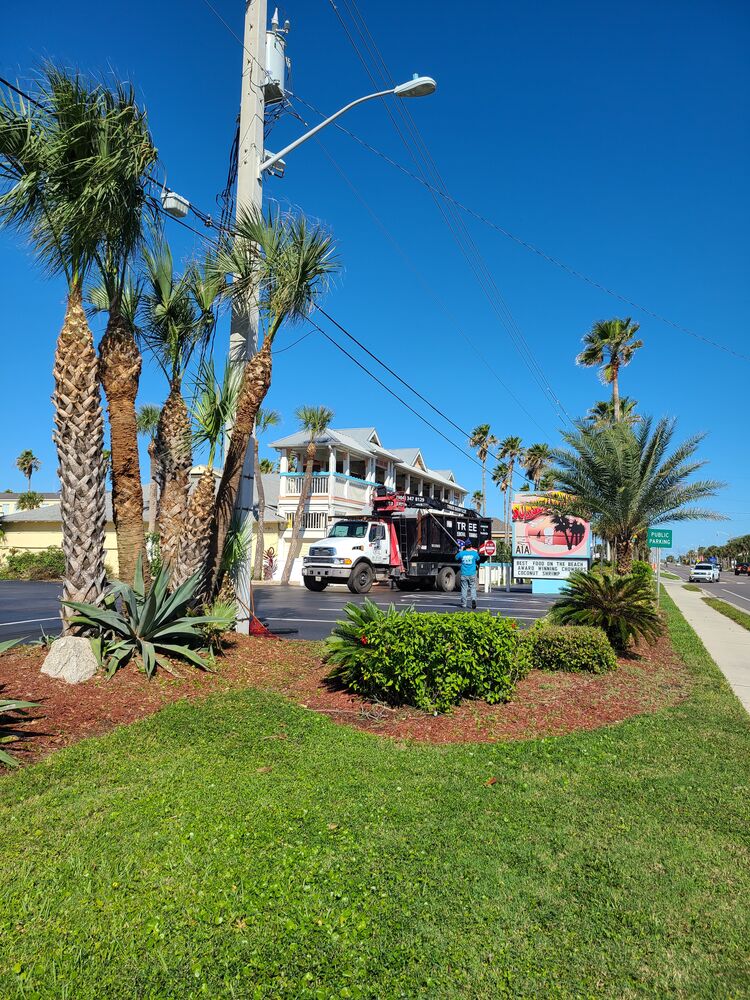The Complete Guide to Pruning, Feeding, and Planting Trees and Shrubs in Northeastern Florida
One of the singular most important landscaping decisions involves selecting the right plants for the right environment. In Northeastern Florida, our climate is unique, characterized by hot and humid summers and mild winters. Careful consideration for their size, growth rate, and planting requirements creates a beautiful and thriving landscape to enhance your home or business. Therefore, choosing plants that can thrive in these conditions is essential.
When it comes to pruning, feeding, and planting, timing is everything. Here are some general guidelines for some of our area’s most common varieties of trees and shrubbery in Northeastern Florida.
Tree Pruning
The best time to prune trees is during the dormant season, which typically occurs in late winter or early spring. This is when the tree is not actively growing, and pruning will not interfere with its growth.
Live Oak (Quercus virginiana)
Live Oaks should be pruned during the dormant season, which typically occurs in late winter or early spring. Pruning should be done to remove dead, diseased, or damaged wood, as well as to thin out the tree’s canopy to allow for better air circulation and light penetration. Avoid heavy pruning, as this can damage the tree and make it more susceptible to disease.
Southern Magnolia (Magnolia grandiflora)
Southern Magnolias should be pruned after they have finished flowering. Pruning should be done to remove dead, diseased, or damaged wood, as well as to shape the tree and remove any crossing or rubbing branches. Avoid heavy pruning, as this can damage the tree and reduce its flowering potential.
Crape Myrtle (Lagerstroemia indica)
Crape Myrtles should be pruned during the dormant season, which typically occurs in late winter or early spring. Pruning should be done to remove dead, diseased, or damaged wood, as well as to shape the tree and promote better flowering. Avoid heavy pruning, as this can reduce the tree’s flowering potential.
Bald Cypress (Taxodium distichum)
Bald Cypress trees do not require regular pruning. However, if pruning is necessary, it should be done during the dormant season to remove dead, diseased, or damaged wood. Avoid heavy pruning, as this can damage the tree and make it more susceptible to disease.
Sweetgum (Liquidambar styraciflua)
Sweetgum trees should be pruned during the dormant season to remove dead, diseased, or damaged wood. Pruning can also be done to shape the tree and remove any crossing or rubbing branches. Avoid heavy pruning, as this can damage the tree and make it more susceptible to disease.
Red Maple (Acer rubrum)
Red Maple trees should be pruned during the dormant season to remove dead, diseased, or damaged wood. Pruning can also be done to shape the tree and remove any crossing or rubbing branches. Avoid heavy pruning, as this can damage the tree and make it more susceptible to disease.
Dogwood (Cornus florida)
Dogwood trees should be pruned after they have finished flowering. Pruning should be done to remove dead, diseased, or damaged wood, as well as to shape the tree and remove any crossing or rubbing branches. Avoid heavy pruning, as this can damage the tree and reduce its flowering potential.
Cherry Laurel (Prunus caroliniana)
Cherry Laurel trees do not require regular pruning. However, if pruning is necessary, it should be done during the dormant season to remove dead, diseased, or damaged wood. Avoid heavy pruning, as this can damage the tree and make it more susceptible to disease.
Wax Myrtle (Myrica cerifera)
Wax Myrtle trees should be pruned during the dormant season to remove dead, diseased, or damaged wood. Pruning can also be done to shape the tree and remove any crossing or rubbing branches. Avoid heavy pruning, as this can damage the tree and make it more susceptible to disease.
Sycamore (Platanus occidentalis)
Sycamore trees should be pruned during the dormant season to remove dead, diseased, or damaged wood. Pruning can also be done to shape the tree and remove any crossing or rubbing branches. Avoid heavy pruning, as this can damage the tree and make it more susceptible to disease.
Tree Feeding
Trees should be fertilized twice a year, once in the spring and once in the fall. Use a slow-release fertilizer that is specifically formulated for trees.
Live Oak (Quercus virginiana)
Live Oaks should be fertilized twice a year, once in the spring and once in the fall. Use a slow-release fertilizer that is specifically formulated for trees. Apply the fertilizer around the tree’s drip line, which is the area directly beneath the outermost branches.
Southern Magnolia (Magnolia grandiflora)
Southern Magnolias should be fertilized once a year in the spring. Use a slow-release fertilizer that is specifically formulated for trees. Apply the fertilizer around the tree’s drip line, which is the area directly beneath the outermost branches.
Crape Myrtle (Lagerstroemia indica)
Crape Myrtles should be fertilized once a year in the spring. Use a slow-release fertilizer that is specifically formulated for trees. Apply the fertilizer around the tree’s drip line, which is the area directly beneath the outermost branches.
Bald Cypress (Taxodium distichum)
Bald Cypress trees do not require regular fertilization. However, if the tree is not growing well or is showing signs of nutrient deficiency, a slow-release fertilizer can be applied in the spring. Apply the fertilizer around the tree’s drip line.
Sweetgum (Liquidambar styraciflua)
Sweetgum trees should be fertilized once a year in the spring. Use a slow-release fertilizer that is specifically formulated for trees. Apply the fertilizer around the tree’s drip line, which is the area directly beneath the outermost branches.
Red Maple (Acer rubrum)
Red Maple trees should be fertilized once a year in the spring. Use a slow-release fertilizer that is specifically formulated for trees. Apply the fertilizer around the tree’s drip line, which is the area directly beneath the outermost branches.
Dogwood (Cornus florida)
Dogwood trees should be fertilized once a year in the spring. Use a slow-release fertilizer that is specifically formulated for trees. Apply the fertilizer around the tree’s drip line, which is the area directly beneath the outermost branches.
Cherry Laurel (Prunus caroliniana)
Cherry Laurel trees should be fertilized once a year in the spring. Use a slow-release fertilizer that is specifically formulated for trees. Apply the fertilizer around the tree’s drip line, which is the area directly beneath the outermost branches.
Wax Myrtle (Myrica cerifera)
Wax Myrtle trees do not require regular fertilization. However, if the tree is not growing well or is showing signs of nutrient deficiency, a slow-release fertilizer can be applied in the spring. Apply the fertilizer around the tree’s drip line.
Sycamore (Platanus occidentalis)
Sycamore trees should be fertilized once a year in the spring. Use a slow-release fertilizer that is specifically formulated for trees. Apply the fertilizer around the tree’s drip line, which is the area directly beneath the outermost branches.
Tree Planting
The best time to plant trees in Northeastern Florida is during the fall and winter months when the weather is cooler and there is less stress on the tree. Common varieties of trees used by landscapers in this area include:
Live Oak (Quercus virginiana)
Live Oaks should be planted in the fall or winter months when the weather is cooler and there is less stress on the tree. Choose a location with well-draining soil and plenty of sunlight. Dig a hole that is twice as wide as the root ball and slightly shallower than the depth of the root ball. Place the tree in the hole and backfill with soil, making sure to tamp down the soil to remove any air pockets.
Southern Magnolia (Magnolia grandiflora)
Southern Magnolias should be planted in the fall or winter months when the weather is cooler and there is less stress on the tree. Choose a location with well-draining soil and plenty of sunlight. Dig a hole that is twice as wide as the root ball and slightly shallower than the depth of the root ball. Place the tree in the hole and backfill with soil, making sure to tamp down the soil to remove any air pockets.
Crape Myrtle (Lagerstroemia indica)
Crape Myrtles should be planted in the fall or winter months when the weather is cooler and there is less stress on the tree. Choose a location with well-draining soil and plenty of sunlight. Dig a hole that is twice as wide as the root ball and slightly shallower than the depth of the root ball. Place the tree in the hole and backfill with soil, making sure to tamp down the soil to remove any air pockets.
Bald Cypress (Taxodium distichum)
Bald Cypress trees should be planted in the fall or winter months when the weather is cooler and there is less stress on the tree. Choose a location with well-draining soil and plenty of sunlight. Dig a hole that is twice as wide as the root ball and slightly shallower than the depth of the root ball. Place the tree in the hole and backfill with soil, making sure to tamp down the soil to remove any air pockets.
Sweetgum (Liquidambar styraciflua)
Sweetgum trees should be planted in the fall or winter months when the weather is cooler and there is less stress on the tree. Choose a location with well-draining soil and plenty of sunlight. Dig a hole that is twice as wide as the root ball and slightly shallower than the depth of the root ball. Place the tree in the hole and backfill with soil, making sure to tamp down the soil to remove any air pockets.
Red Maple (Acer rubrum)
Red Maple trees should be planted in the fall or winter months, when the weather is cooler and there is less stress on the tree. Choose a location with well-draining soil and plenty of sunlight. Dig a hole that is twice as wide as the root ball and slightly shallower than the depth of the root ball. Place the tree in the hole and backfill with soil, making sure to tamp down the soil to remove any air pockets. Water the tree thoroughly after planting.
Pruning Shrubs
Shrubs should be pruned after they have finished flowering. This will ensure that you do not remove any new buds that have formed for the next growing season.
Azalea (Rhododendron spp.)
Azaleas should be pruned after they have finished flowering. Pruning should be done to remove dead, diseased, or damaged wood, as well as to shape the plant and remove any crossing or rubbing branches. Avoid heavy pruning, as this can damage the plant and reduce its flowering potential.
Indian Hawthorn (Rhaphiolepis spp.)
Indian Hawthorns should be pruned after they have finished flowering. Pruning should be done to remove dead, diseased, or damaged wood, as well as to shape the plant and remove any crossing or rubbing branches. Avoid heavy pruning, as this can damage the plant and reduce its flowering potential.
Ligustrum (Ligustrum spp.)
Ligustrums should be pruned in late winter or early spring to remove dead, diseased, or damaged wood and shape the plant. Use sharp pruning shears to make cuts just above a leaf node or bud at a 45-degree angle. Avoid heavy pruning to maintain flowering potential. For rejuvenation, cut the plant back to about one-third of its height, leaving some healthy leaves on each stem. Clean up debris after pruning to prevent disease and pest spread.
Loropetalum (Loropetalum chinense)
Loropetalums should be pruned in late winter or early spring to remove dead, diseased, or damaged wood and shape the plant. Use sharp pruning shears to make cuts at a 45-degree angle just above a leaf node or bud. Avoid heavy pruning to maintain flowering potential. For rejuvenation, cut the plant back to about one-third of its height, leaving some healthy leaves on each stem. Clean up debris after pruning to prevent disease and pest spread.
Viburnum (Viburnum spp.)
Viburnums should be pruned after they have finished flowering. Pruning should be done to remove dead, diseased, or damaged wood, as well as to shape the plant and remove any crossing or rubbing branches. Avoid heavy pruning, as this can damage the plant and reduce its flowering potential.
Boxwood (Buxus spp.)
Boxwoods can be pruned at any time of year, but it is best to avoid pruning during extreme heat or cold. Pruning should be done to remove dead, diseased, or damaged wood, as well as to shape the plant and maintain its desired size. Avoid heavy pruning, as this can damage the plant and make it more susceptible to disease.
Camellia (Camellia spp.)
Camellias should be pruned after they have finished flowering. Pruning should be done to remove dead, diseased, or damaged wood, as well as to shape the plant and remove any crossing or rubbing branches. Avoid heavy pruning, as this can damage the plant and reduce its flowering potential.
Gardenia (Gardenia jasminoides)
Gardenias should be pruned after they have finished flowering. Pruning should be done to remove dead, diseased, or damaged wood, as well as to shape the plant and remove any crossing or rubbing branches. Avoid heavy pruning, as this can damage the plant and reduce its flowering potential.
Holly (Ilex spp.)
Hollies should be pruned in the late winter or early spring before new growth begins. Pruning should be done to remove dead, diseased, or damaged wood, as well as to shape the plant and remove any crossing or rubbing branches.
Nandina (Nandina domestica)
Nandinas should be pruned in the late winter or early spring before new growth begins. Pruning should be done to remove dead, diseased, or damaged wood, as well as to shape the plant and promote better growth. Avoid heavy pruning, as this can damage the plant and make it more susceptible to disease.
Feeding Shrubs
Shrubs should be fertilized once a year in the spring. Use a slow-release fertilizer that is specifically formulated for shrubs.
Azalea (Rhododendron spp.)
Azaleas benefit from fertilization in the early spring, just before new growth begins. Use a fertilizer specifically formulated for acid-loving plants and follow the instructions on the package for the correct application rate. Avoid over-fertilizing, as this can damage the plant.
Indian Hawthorn (Rhaphiolepis spp.)
Indian Hawthorns benefit from fertilization in the early spring, just before new growth begins. Use a balanced, slow-release fertilizer, and follow the instructions on the package for the correct application rate. Avoid over-fertilizing, as this can damage the plant.
Ligustrum (Ligustrum spp.)
Ligustrums benefit from fertilization in the early spring, just before new growth begins. Use a balanced, slow-release fertilizer, and follow the instructions on the package for the correct application rate. Avoid over-fertilizing, as this can damage the plant.
Loropetalum (Loropetalum chinense)
Loropetalums benefit from fertilization in the early spring, just before new growth begins. Use a balanced, slow-release fertilizer, and follow the instructions on the package for the correct application rate. Avoid over-fertilizing, as this can damage the plant.
Viburnum (Viburnum spp.)
Viburnums benefit from fertilization in the early spring, just before new growth begins. Use a balanced, slow-release fertilizer, and follow the instructions on the package for the correct application rate. Avoid over-fertilizing, as this can damage the plant.
Boxwood (Buxus spp.), Camellia (Camellia spp.)
Boxwoods and Camellias benefit from fertilization in the early spring, just before new growth begins. Use a balanced, slow-release fertilizer, and follow the instructions on the package for the correct application rate. Avoid over-fertilizing, as this can damage the plant.
Gardenia (Gardenia jasminoides)
Gardenias benefit from fertilization in the early spring and again in mid-summer. Use a fertilizer specifically formulated for acid-loving plants and follow the instructions on the package for the correct application rate. Avoid over-fertilizing, as this can damage the plant.
Holly (Ilex spp.)
Hollies benefit from fertilization in the early spring, just before new growth begins. Use a balanced, slow-release fertilizer, and follow the instructions on the package for the correct application rate. Avoid over-fertilizing, as this can damage the plant.
Nandina (Nandina domestica)
Nandinas benefit from fertilization in early spring and again in mid-summer. Use a balanced, slow-release fertilizer, and follow the instructions on the package for the correct application rate. Avoid over-fertilizing, as this can damage the plant.
Planting Shrubs
The best time to plant shrubs in Northeastern Florida is during the fall and winter months when the weather is cooler and there is less stress on the plant.
Azalea (Rhododendron spp.)
Azaleas prefer acidic, well-draining soil and partial shade. Plant them in a location that receives morning sun and afternoon shade. Dig a hole that is two to three times wider than the root ball and slightly shallower than the depth of the root ball. Mix in some organic matter, such as compost or peat moss, to improve soil drainage and fertility. Place the plant in the hole, backfill with soil, and water thoroughly.
Indian Hawthorn (Rhaphiolepis spp.)
Indian Hawthorns prefer well-draining soil and full sun to partial shade. Plant them in a location that receives at least six hours of direct sunlight per day. Dig a hole that is two to three times wider than the root ball and slightly shallower than the depth of the root ball. Mix in some organic matter, such as compost or peat moss, to improve soil drainage and fertility. Place the plant in the hole, backfill with soil, and water thoroughly.
Ligustrum (Ligustrum spp.)
Ligustrums prefer well-draining soil and full sun to partial shade. Plant them in a location that receives at least six hours of direct sunlight per day. Dig a hole that is two to three times wider than the root ball and slightly shallower than the depth of the root ball. Mix in some organic matter, such as compost or peat moss, to improve soil drainage and fertility. Place the plant in the hole, backfill with soil, and water thoroughly.
Loropetalum (Loropetalum chinense)
Loropetalums prefer well-draining soil and full sun to partial shade. Plant them in a location that receives at least six hours of direct sunlight per day. Dig a hole that is two to three times wider than the root ball and slightly shallower than the depth of the root ball. Mix in some organic matter, such as compost or peat moss, to improve soil drainage and fertility. Place the plant in the hole, backfill with soil, and water thoroughly.
Viburnum (Viburnum spp.)
Viburnums prefer well-draining soil and full sun to partial shade. Plant them in a location that receives at least six hours of direct sunlight per day. Dig a hole that is two to three times wider than the root ball and slightly shallower than the depth of the root ball. Mix in some organic matter, such as compost or peat moss, to improve soil drainage and fertility. Place the plant in the hole, backfill with soil, and water thoroughly.
Boxwood (Buxus spp.), Camellia (Camellia spp.)
Boxwoods and Camellias prefer well-draining soil and partial shade. Plant them in a location that receives morning sun and afternoon shade. Dig a hole that is two to three times wider than the root ball and slightly shallower than the depth of the root ball. Mix in some organic matter, such as compost or peat moss, to improve soil drainage and fertility. Place the plant in the hole, backfill with soil, and water thoroughly.
Gardenia (Gardenia jasminoides)
Gardenias prefer acidic, well-draining soil and partial shade. Plant them in a location that receives morning sun and afternoon shade. Dig a hole that is two to three times wider than the root ball and slightly shallower than the depth of the root ball. Mix in some organic matter, such as compost or peat moss, to improve soil drainage and fertility. Place the plant in the hole, backfill with soil, and water thoroughly.
Holly (Ilex spp.)
Hollies prefer well-draining soil and full sun to partial shade. Plant them in a location that receives at least six hours of direct sunlight per day. Dig a hole that is two to three times wider than the root ball and slightly shallower than the depth of the root ball. Mix in some organic matter, such as compost or peat moss, to improve soil drainage and fertility. Place the plant in the hole, backfill with soil, and water thoroughly.
Nandina (Nandina domestica)
Nandinas prefer well-draining soil and full sun to partial shade. Plant them in a location that receives at least six hours of direct sunlight per day. Dig a hole that is two to three times wider than the root ball and slightly shallower than the depth of the root ball. Mix in some organic matter, such as compost or peat moss, to improve soil drainage and fertility. Place the plant in the hole, backfill with soil, and water thoroughly.
In addition to selecting the right plants, it is also important to consider other factors that can impact their growth and health. These include soil quality, water availability, and sunlight exposure. Proper irrigation and drainage are essential to ensure that plants receive adequate water without becoming waterlogged.
Furthermore, it is important to regularly monitor your landscape for pests and diseases. Early detection and treatment can prevent significant damage and help your plants thrive. Consult with a professional if you are unsure about how to identify or treat any issues.
Our Services
• Commercial Tree Services
• Expert Residential Tree Services
• Tree Removal & Yard Debri Cleanup
• Emergency Tree Removal
• Affordable Tree Trimming , including Palm Trimming
• Expert Tree Pruning
• Brush & Palmetto Clearing
• Tree Stump Grinding
• Landscape Hauling
• Post Storm Cleanup & Debris Removal
• Grapple Truck Work
• Brush Removal Services
• Small Project Land Clearing
• Comprehensive Tree Care and Maintenance Services

W.C.H. Debris Removal and Tree Service is licensed and insured, holds a 4.7-star rating on Google, and has been screened and approved by HomeAdvisor.



Customer Reviews

Great, very good to communicate progress of this job. He even suggested future maintenance issues. Great work.
Susa M.

They were terrific to work with. I would highly recommend them, as they went above and beyond
Vince B.

William is awesome! Would recommend to anyone!
Sara D.

Quick, easy, affordable and courteous service.
Tim D.

William Hill just a nice professional fella will recommend him to my best friends I m going put him on my recommendation list for my community website!
Pauline M.

Great service. Came right over, did the work I needed doing.
Lowell W.

